BMWdiy.INFO
E39 Euro-spec CELIS "Angel Eye"
Head Light Installation
Prepared by VietSB
Modified 01.04.04
NOTE: Perform these steps at your own risk. All P/N's listed are a "best guess", so please double-check with your local dealer. These mods and repairs were performed on my US-spec 1997 540iA (11/96 prod date, M62 engine) but there is no guarantee they will work on other E39's. These instructions are provided for entertainment purposes only!
BACKGROUND: This DIY covers the install of Euro-spec CELIS (aka Angel Eye or halo) assemblies on a pre-2001 E39 to mimic the newer-style 2001+ E39 head lights. Note that the Euro-spec assemblies do not have the small side parking indicator, which is required for DOT-approval.
Please Note: These upgrade parts are possibly available at Evosport.com, Bekkers.com, Supreme Power Parts, or Bavarian Autosport. I haven't bought from these vendors recently, so please don't e-mail me asking for sources. Check with these vendors or ask on the Roadfly.com E39 Message Board for more recent references.
Required Parts:
- Hella Euro-spec Xenon CELIS clear-corner head light assemblies (pic below). A very complete list of the different styles can be found on BMWTips.com).
- Head light mounting brackets (should be included with head lights)
- Pre-wired turn-signal/parking light Y-harness adapter (pic below). Detailed info can be found on BMWTips.com. If you require the harness pieces, buy these harnesses from the dealer and assemble them using the BMWTips.com instructions.
- (Qty 2) P/N 63 12 0 025 497
- (Qty 2) P/N 63 12 0 025 499
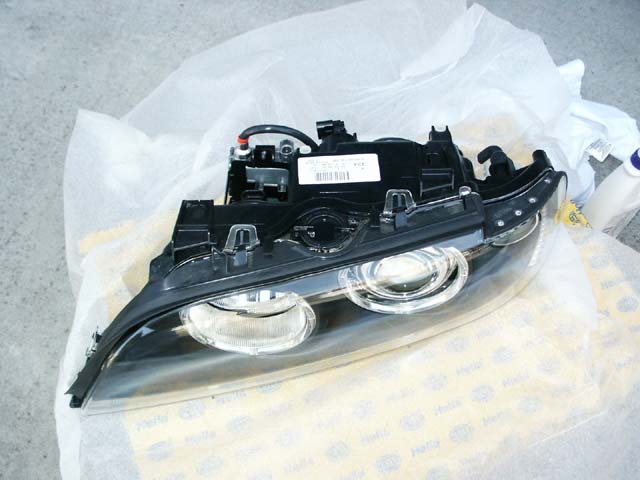
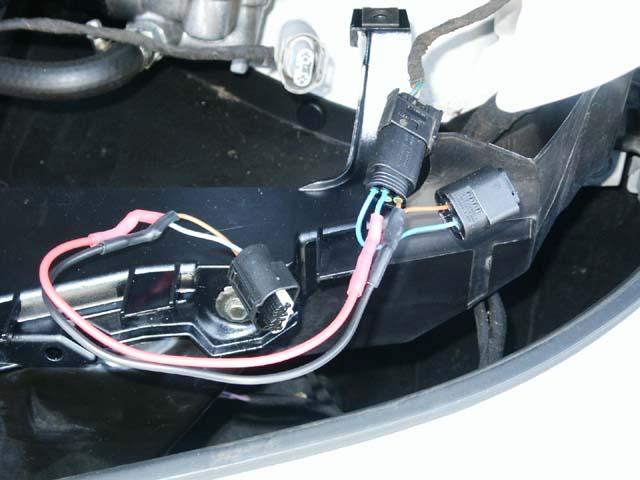
Recommended Parts:
- Philips Ultinon 6000K Xenon HID bulbs (D2S)
- Philips PY21W SilverVision bulbs
- Hella resistor packs - Important! Click and read the link to see if they are required on your vehicle.
- Newer-style Hella/Philips ballasts - Important! Check Step 1 below to see if they need to be purchased. (I've mainly noticed older-style ballasts on pre-2000 vehicles.)
Required Tools:
- Ratchet, extension, 8mm socket
- Flat-head screwdriver
Recommend Tools:
- Rubber gloves
- Magnetic pick-up tool and flashlight in case of an "incident"
- Properly-sized pipe bending tool
- Masking tape
- 6mm hex key
1. Check your existing ballasts. If they look like the one pictured below, they will not work since the new ballast mounting bracket is sized for the newer-style ballasts and the bulb connector won't fit at all. Stop until you obtain the correct ballasts.
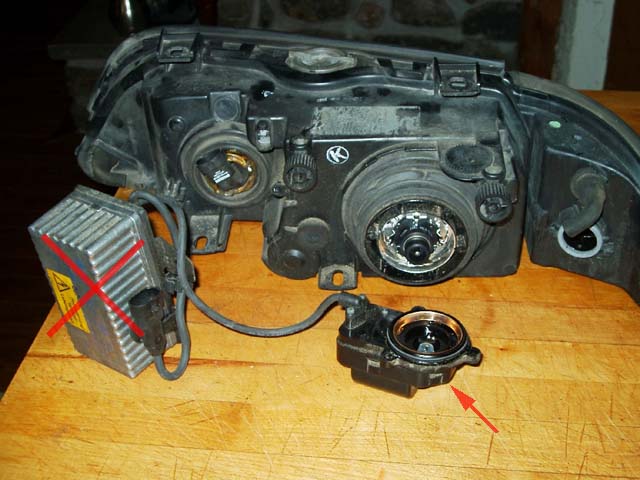
2. Park against a wall and use masking tape to mark the approximate focus point of the low beams for future reference.
3. Remove the existing headlight assemblies. Refer to the Head Light Removal DIY if needed.
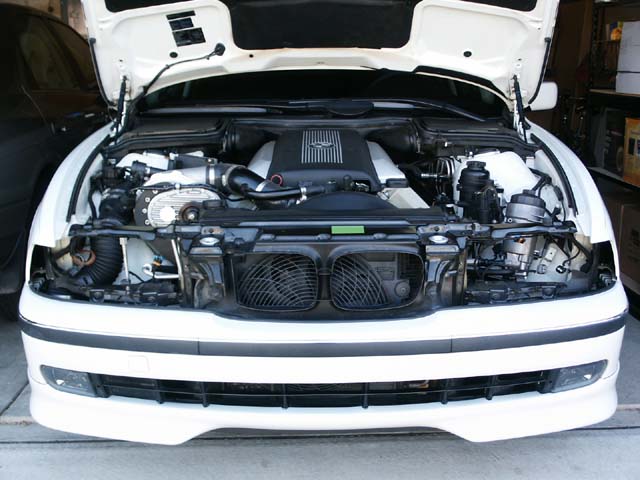
4. Remove the new mounting bracket from the CELIS assembly by removing the two screws (see red arrows) and pulling it in the direction of the blue arrow.
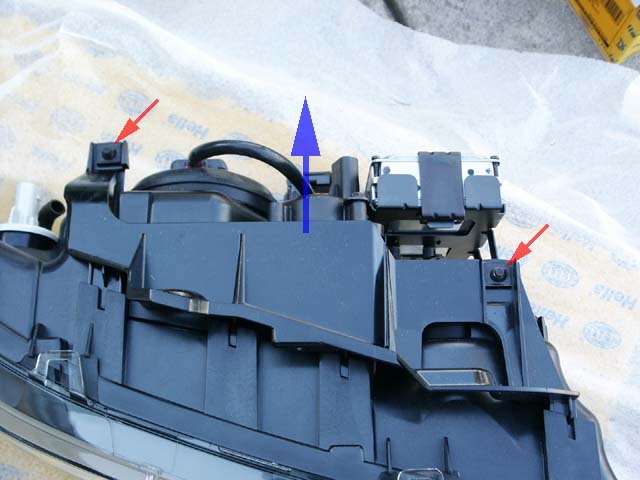
5. Remove the old mounting bracket on the car by removing the (2) screws (top pic) and replace it with the new bracket (bottom pic).
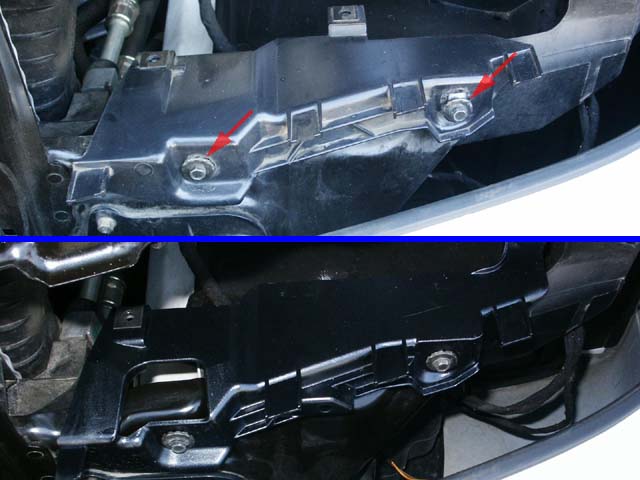
6. Install the body-colored trim piece from the old assembly onto the CELIS assembly. Be careful not to break the fragile end-hook.
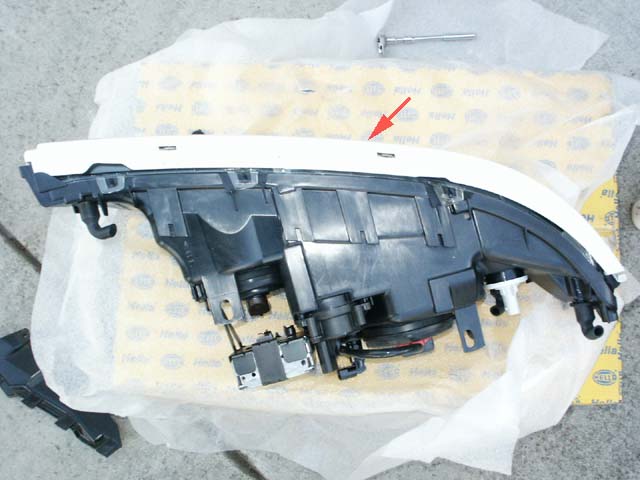
7. Use the Y-harness to split the existing combo turn-signal/parking light connector into two separate plugs.

iT Wagon Owners Note: Some (approx) pre-2000 model vehicles had a differently-wired combo connector with only 2 wires instead of 3. This poses a major hurdle since the Y-harness won't send a 12V signal to the new CELIS parking light halo rings. I'd suggest you check on BMWTips.com (no solution posted so far) or ask the bimmer.org board for assistance as I haven't heard of an implemented solution yet. Scroll to the bottom for some untested "hypothetical" solutions. If you find an answer, please e-mail me so I can ad the info to this site. Here's a picture of the unique stock wiring.
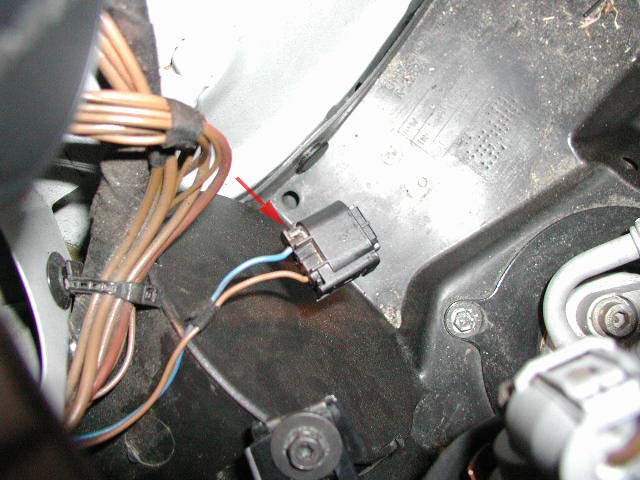
8. Hook-up all the appropriate wires and carefully slide the assembly in place, but with more of a "straight ahead" motion than the previous "rotating" motion. Protect the bumper while installing the assembly. Secure with the (4) original screws, using the ratchet and magnetic pickup-tool as necessary. Here are pics of the completed driver-side assembly. Since this is a Halogen to Xenon upgrade, I don't have the self-leveling connector (see red arrow) to plug in. I plan to wire in the manual adjustment knob harness sometime down the road. (Thx Tyrone!)
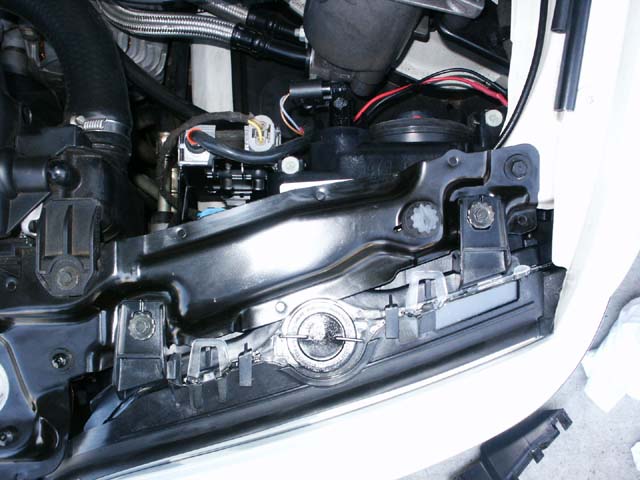
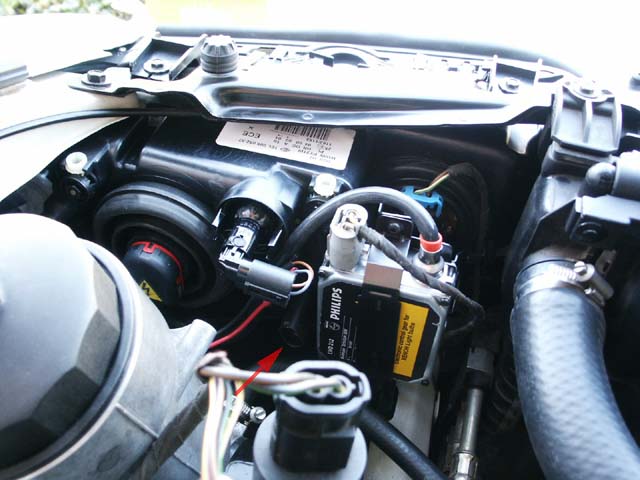
9. On most OEM Halogen E39's, the switch to CELIS will require the passenger-side A/C filler tube to be bent back for clearance. I used a tube-bending tool to be absolutely safe. Carefully bending it straight back by hand has been a simple and effective way of doing it for many folks, but be cautious not to break any part of the tubing, allowing R134A to escape.
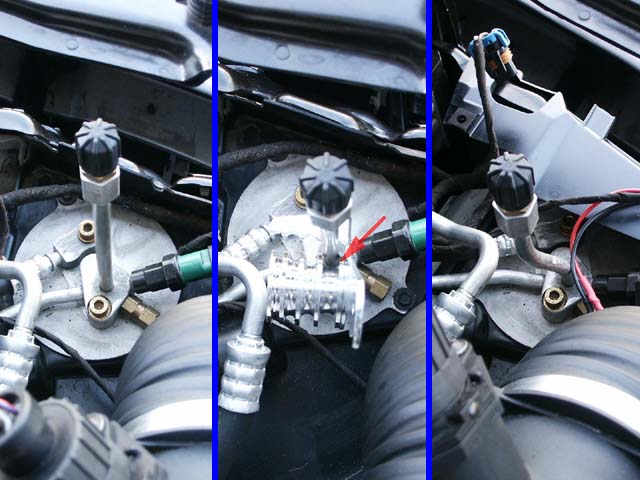
10. Here's are pics of the completed passenger-side assembly.
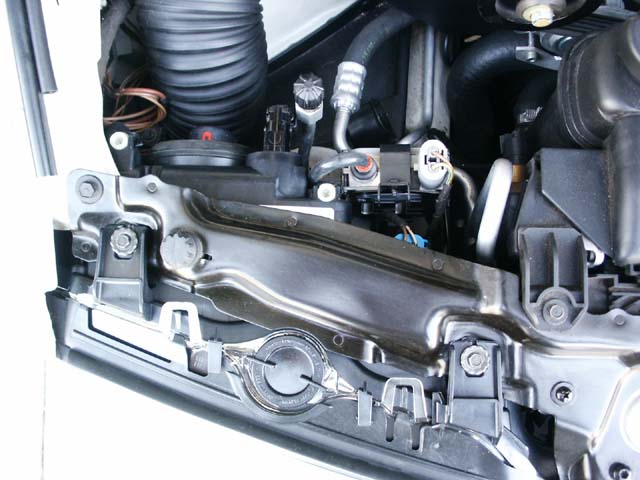
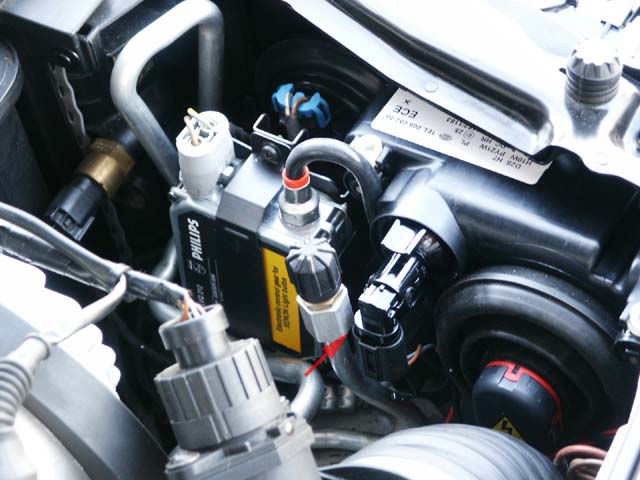
11. Check to see if the new assemblies line-up properly. The screw points have some play to allow them to be moved around a bit. Check that all the bulbs work properly and have the head lights professionally aimed. If you followed Step #2, you can get an approximate beam alignment using the masking tape lines and by turning the assembly adjusters with the 6mm hex key.
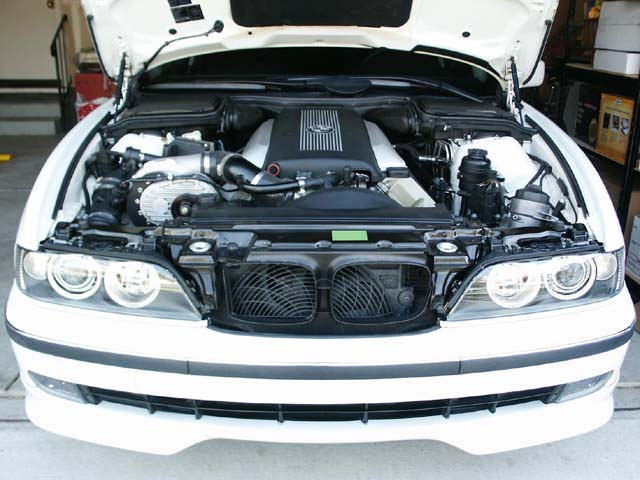
Special notes for iT Wagon Owners with 2-wire plug issue:
If you're good with car electronics or know a quality car stereo/alarm place you trust, here are some possible options:
- Tap the CELIS rings off the low beams.
- Splice into your headlight wiring to power the CELIS rings. If you have Xenon lights, be sure to splice into the line prior to the ballast.
- Plug or adapt the existing wiring into the blinker only. This causes the blinker to act exactly as previously intended, dimly lit with the parking lights and brightly flashing with the blinkers.
- Pros: CELIS rings light with the low beams and simple hookup.
- Cons: Must splice into OEM wiring.
- What is non-OEM: CELIS rings don't light with the parking lights. Blinkers will be dimly lit with parking lights.
- Tap the CELIS rings off the fog lights.
- Splice into your fog light wiring to power the CELIS rings.
- Plug or adapt the existing wiring into the blinker only. This causes the blinker to act exactly as previously intended, dimly lit with the parking lights and brightly flashing with the blinkers.
- Pros: CELIS rings light with the fog lights and simple hookup.
- Cons: Must splice into OEM wiring.
- What is non-OEM: CELIS rings don't light with the parking lights. Blinkers will be dimly lit with parking lights. Fog lights must be on at all times to light the CELIS rings.
- OEM-like solution, but difficult.
- Find 2 types of durable 12V relays that are tested so one triggers at the lower "parking light" voltage and the other triggers at the higher "blinker" voltage (probably 12V) of the OEM wiring harness. Find and cleanly tap a properly-fused 12V power lead into the engine compartment to feed the switched-circuit portion of the relays. The low voltage trigger relay should be wired to send 12V to the CELIS rings when the parking lights are on and the high voltage trigger relay wired to flash the blinkers as needed. A setup using 2 relays total could power both sides, but I think building separate dual-relay packs for each side would be cleaner and possibly avoid light bulb Check Control system issues.
- Pros: I believe this will work exactly as an OEM CELIS setup. Using the wiring plug adapters, this could be a "plug in" solution instead of splicing into the OEM wiring.
- Cons: Must find the lower trigger voltage relay, if it even exists and build/mount weather-proof relay packs. Must cleanly tap 12V from an appropriate power source.
- OEM-like solution, but difficult and untested.
- Find durable 12V relays that are tested to trigger at the lower "parking light" voltage. Find and cleanly tap a properly-fused 12V power lead into the engine compartment to feed the switched-circuit portion of the relays. The trigger relay should be wired to send 12V to the CELIS rings when the parking lights are on. A setup using 1 relay total could power both sides, but I think building separate relay packs for each side would be cleaner and possibly avoid light bulb Check Control system issues.
- Tap the turn signal blinkers off the sidemarker bulbs so they blink together. I'm unsure how difficult it is to splice into the sidemarker bulbs, if there's sufficient voltage to power both sets of bulbs, and how it might adversely affect the light bulb Check Control system. Definitely proceed at your own risk.
- Pros: I believe this will work exactly as an OEM CELIS setup.
- Cons: Must find the lower trigger voltage relay, if it even exists and build/mount weather-proof relay packs. Must cleanly tap 12V from an appropriate power source. Must splice into OEM wiring. Shared power concerns. Light Check Control system affect is unknown.
- Close to OEM-like solution.
- Find durable 12V relays that are tested they trigger at the lower "parking light" voltage. Find and cleanly tap a properly-fused 12V power lead into the engine compartment to feed the switched-circuit portion of the relays. The trigger relay should be wired to send 12V to the CELIS rings when the parking lights are on. A setup using 1 relay total could power both sides, but I think building separate relay packs for each side would be cleaner and possibly avoid light bulb Check Control system issues.
- Plug or adapt the existing wiring into the blinker only. This causes the blinker to act exactly as previously intended, dimly lit with the parking lights and brightly flashing with the blinkers.
- Pros: The CELIS rings will light with the parking lights and independent of the low beams or fog lights. Using the wiring plug adapters, this could be a "plug in" solution instead of splicing into the OEM wiring.
- Cons: Must find the lower trigger voltage relay, if it even exists and build/mount weather-proof relay packs. Must cleanly tap 12V from an appropriate power source.
- What is non-OEM: Blinkers will be dimly lit with parking lights.
Challenges with the above solutions:
- Must be comfortable with basic car electrical principles.
- Where to cleanly and safely tap 12V in or into the engine compartment
- Build relay packs that are weather-proof, won't overheat/fail, and look/mount in an OEM fashion.
- Use OEM-type wire plugs to keep everything fairly stock in appearance.
|
Questions? Comments? E-mail me:
|
 . .
|
Click Here to return to the Main Menu.

Optimized for 800x600 or higher resolution.
Copyright © Midnight Designs, 2004. All Rights Reserved. All
images and registered trademarks are used to benefit and without intent to
infringe on the holder. Contents Subject to Change Without Notice.
















 .
.